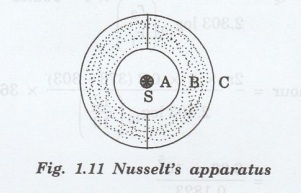Physics For Civil Engineering: Unit I: Thermal Application
Thermal Conductivity of Powder Material
Principle, Main Components, Procedure, Formula
Nusselt and others used the spherical shell method to determine the conductivity of poor conductors available in the form of powder or fibres i.e., sand, asbestos, cork, clay etc. The method can also be used to determine the conductivity of gases.
THERMAL CONDUCTIVITY OF POWDER MATERIAL
Nusselt and others used the spherical
shell method to determine the conductivity of poor conductors available in the
form of powder or fibres i.e., sand, asbestos, cork, clay etc. The method can
also be used to determine the conductivity of gases.
Nusselt's method - The arrangement of
Nusselt's method is diagrammatically represented in fig. 1.11
The material B under test is packed into
the space between two concentric hollow spheres, C and A, made of copper and
aluminium of radii 15 cm and 7.5 cm
The spheres can be split into halves and
reunited along a dividing line. An electrically heated body S is placed at the centre
of the sphere inside A and electrical energy is supplied to it at a constant
rate.
Temperatures θ1, θ2
are determined by thermocouples fitted in the material B. at different
distances, say r = r1 and r = r2, from the centre and
along or more radii.

If I be the current that flows in S
under a potential difference E, then in the steady state the heat equivalent of
electrical energy spent per second is
Q = EI/J…………………..(1)
With this value of Q in equation (1), we
obtainи

Since all the quantities of Eqn.(2) are
known, K can be readily evaluated
Note:
• In this experiment, the pressure at which K is determined must be recorded for the conductivities of powdered or fibrous solids always depend on the pressure applied.
Fenestration
It refers to the presence of openings in a building, most notably the doors and windows.
Definition
Any opening in a building such as windows, doors, curtain walls and skylights which are designed to permit the passage of air, light, vehicles or people is called fenestration.
Fenestration
System
There are various fenestration systems
like glazing, windows, curtain walls, sloped glazing and external doors.
• Glazing (transparent): Glass is used for transmission of
natural light into a building and weather shielding. This has led to glazing of
majority of the new windows.
• Windows: Windows mainly use wooden frame, or metal windows
(iron, steel and aluminium).
• Curtain walls: A curtain wall is any exterior wall that
is attached to the building structure. It does not carry roof loads of the
building.
• Sloped glazing: Skylights are used to provide interior
day lighting through this sloped glazing.
• Exterior doors: These include entrance and exit doors.
• Emergency route: Escape route in case of fire in low
rise buildings.
Main
Components of Fenestration
Fenestration consists of 3 main
components. They are
(a)
Glazing
(b) Framing
(c) Shading devices and screens
(a) Glazing
It is a main part of fenestration that
allows the light. It is usually made of glass or plastic.
(b) Framing
It is a material that holds the glazing
in place. It is usually made of wood, metal, plastic or fiberglass.
(c) Shading devices and
screens
Shading is a provision used to avoid
incident of light directly on the glazing.
Physics For Civil Engineering: Unit I: Thermal Application : Tag: : Principle, Main Components, Procedure, Formula - Thermal Conductivity of Powder Material
Related Topics
Related Subjects
Physics for Civil Engineering
PH3201 2021 Regulation | 2nd Semester Civil Dept 2021 Regulation
